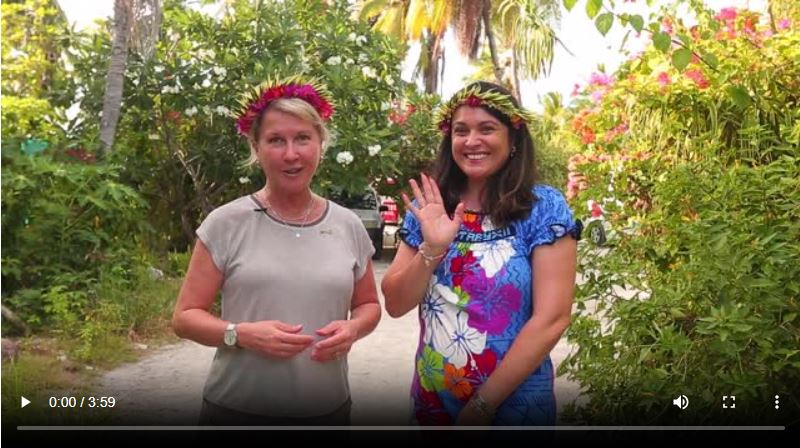
Healthier lives ahead for South Pacific children
Rotary’s Give Every Child a Future program vaccinates 100,000 young people
By Etelka Lehoczky
The island countries of the South Pacific are tropically warm, economically diverse, and really, really far apart. In this region, which spans millions of square miles, even individual countries’ islands are scattered across vast distances. Public health workers face unique challenges in vaccinating the islands’ children.
“It’s hard to transport vaccines to the outer islands because of the distance and transport availability. Sometimes they have to wait one to three months to get a boat across,” says Rufina Tutai, who oversees immunizations for the Cook Islands. The 15 islands in her jurisdiction are spread over nearly 2 million square kilometers (770,000 square miles).
“Flights are expensive to charter, and we’re lucky if a flight can go to the outer islands in less than two weeks,” she adds.
Such obstacles didn’t deter the Rotarians of Australia, New Zealand, and several Pacific Island countries from organizing a major vaccination program in the islands. Called Give Every Child a Future, the effort – which celebrates 100 years of Rotary in the region – is providing three new vaccines to 100,000 children in nine Pacific Island groups: the Cook Islands, Kiribati, Nauru, Niue, Samoa, Tokelau, Tonga, Tuvalu, and Vanuatu.
“Public health programs in the developing world are some of the most effective forms of assistance we can provide. The payback is just enormous,” says James Allen, a member of the Rotary Club of Sydney, New South Wales, Australia, and the project’s director. “We agreed that the Pacific was the area we wanted to focus on because it was in both New Zealand’s and Australia’s backyards.”
Give Every Child a Future took about eight years to develop. At first, the Rotary members knew only that they wanted to raise enough money to have a major impact on childhood health – more than US$1 million. Their goal didn’t crystallize until they found a partner capable of helping them carry out the kind of effort they dreamed of. UNICEF, which has frequently worked with Rotary, was the ideal partner. At first, though, UNICEF officials weren’t certain the Rotary members could fund a comprehensive intervention.
“It took several emails before they realized I was serious,” Allen says. “But then they came back and said, ‘This sounds like a really good idea.’”
UNICEF’s representatives suggested that the effort focus on immunizing children using new vaccines for rotavirus, pneumococcal bacteria, and human papillomavirus (HPV). Rotavirus, which causes diarrheal disease in very young children, and pneumonia are among the top three causes of mortality in Pacific Islander children under five, says Libby Hodgson, chief marketing officer for UNICEF Australia. And HPV vaccination for adolescent girls can prevent them from developing cervical cancer later in life.
“We looked for gaps in the routine immunization schedule in those countries, and at the impact those diseases were having on children,” Hodgson says. “There’s also a high burden of cervical cancer cases across the Pacific, and most of that is attributable to HPV.”
The scope of the program meant that Rotary clubs in the region needed to raise around US$3.9 million – almost twice what they’d initially imagined. “We thought, ‘Well, that’s ambitious.’ But after all, we wanted to do something significant,” Allen says.
Ultimately, the members applied for 23 global grants, securing more than US$980,000 in funds from The Rotary Foundation. The program was also funded by about US$807,000 in District Designated Funds, US$990,000 from clubs and individual members, US$264,000 from other foundations, and US$860,000 from the Australian government.
That funding paid for much more than vaccines. It was used to purchase special refrigerators, insulated containers, and other equipment to keep vaccines cool and transport them to the most distant islands. The health ministries in the nine island groups will be able to use this equipment for many years. That fulfills the project’s other goal of helping the targeted areas add the three vaccines to their regular immunization schedules.
“This program is not just about vaccinating 100,000 children,” says Michelle Tanner, 2016-17 president of the Rotary Club of Matamata, Waikato, New Zealand, and the marketing chair for Give Every Child a Future. “This program is about strengthening primary health care systems and vaccine delivery systems. It’s about expanding staff capacity and updating equipment. And it’s about updating policies and procedures, such as record-keeping.”
The program also trained almost 900 health workers, meeting a critical need.
“What we face is mainly a shortage of staff,” Tutai says. “That’s because it’s our policy to have at least two registered nurses double-check a vaccine before giving it to the child.”
Jennifer Jones, Rotary’s president in 2022-23, visited the Pacific Islands in March 2023 to review and promote the program.
“I had a chance to talk with one couple [whose] son had been immunized but still contracted rotavirus. Because of [the immunization], he was able to survive,” Jones said during her visit. “The fact that we can be here, that we can give every child a future – this is what we do. We deliver on the promises we make.”
RELATED STORIES
